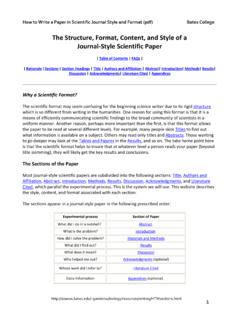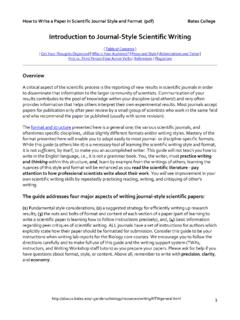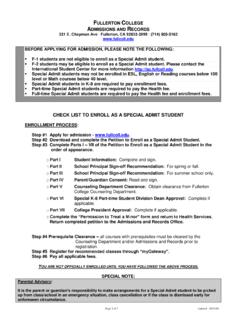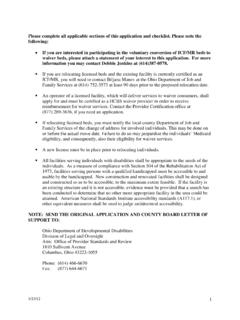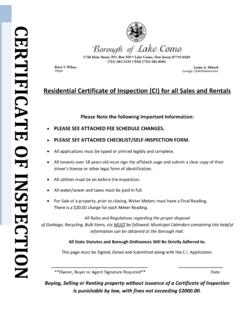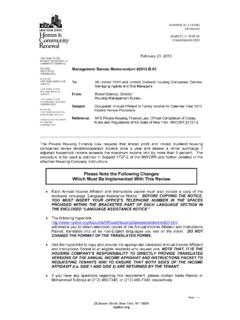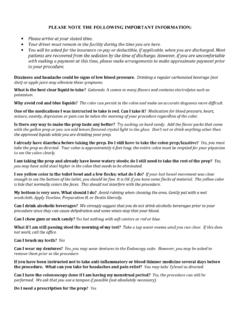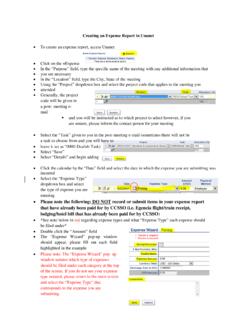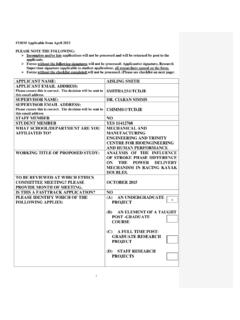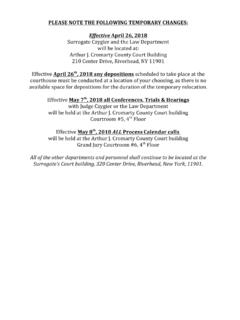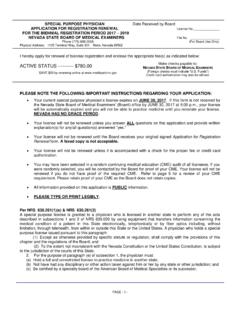Transcription of PLEASE NOTE THE FOLLOWING - Bates College
1 CHEMISTRY WORKED-OUT ANSWERS TO HOMEWORK 6e. PLEASE NOTE THE FOLLOWING : a. Conversions of moles to grams or grams to moles always use molecular weights. b. Conversions that change moles of one substance to moles of another are always based on a balanced equation. When using such an equation, say to yourself, for every so many moles of one thing, there are so many moles of another. For example, in problem 1, for every 2 moles of SO2 , you need 2. moles of H2S and 3 moles of O2 . Watch how these ratios show up in the problems below. 1. Hydrogen sulfide burns by combining with atmospheric O2 to form sulfur dioxide and water vapor. BALANCED EQUATION: 2 H2S + 3 O2 ----- > 2 SO2 + 2 H2O. a. If I produce 200. g of sulfur dioxide, how much hydrogen sulfide did I start with? Molecular weights: H2S = * 2 + = ; SO2 = + 2 * = 200. g of SO2 * ( 1 mole of SO2 ) * ( 2 moles of H2S ) * ( g of H2S ).
2 ( g of SO2 ) ( 2 moles of SO2 ) ( 1 mole of H2S ). = 106. g of H2S (to 3 sig. figs. because the initial 200. g had 3 sig. figs.). b. If I allow 150. g of H2S to react with moles of oxygen, how many grams of SO2 will form? FIRST, find out how much SO2 can be made from 150. g of H2S: 150. g of H2S * ( 1 mole of H2S ) * ( 2 moles of SO2 ) * ( g of SO2 ). ( g of H2S ) ( 2 moles of H2S ) ( 1 mole of SO2 ). = 282. g of SO2 (to 3 sig. figs. because the initial 150. g had 3 sig. figs.);. I therefore have enough H2S to make 282. g of SO2 . SECOND, find out how much SO2 can be made from moles of oxygen: mol of O2 * ( 2 moles of SO2 ) * ( g of SO2 ). ( 3 moles of O2 ) ( 1 mole of SO2 ). = g of SO2 ; I therefore have enough O2 to make g of SO2 . NOW, CHOOSE THE REACTANT WITH THE LOWER YIELD OF PRODUCT. Oxygen is the limiting reactant because I only have enough to make g of SO2 . Once I have made g of SO2 , the reaction will stop because I will run out of oxygen.
3 (There will be some extra H2S left over; this amount is the excess, , more than we need.). CONTINUED ON REVERSE SIDE. 2. Phosphoric acid is produced commercially in the FOLLOWING reaction: Ca3(PO4)2 + 3 H2SO4 ----- > 3 CaSO4 + 2 H3PO4. MOLECULAR WEIGHTS: Ca3(PO4)2 = * 3 + * 2 + * 8 = H3PO4 = * 3 + + * 4 = If a production plant has kg of calcium phosphate and moles of sulfuric acid, a. how much phosphoric acid can they make? FIRST, find out how much phosphoric acid can be made from kg of calcium phosphate: kg of Ca3(PO4)2 * ( 1000 g ) * ( 1 mole of Ca3(PO4)2 ) * ( 2 moles of H3PO4 ). 1 kg ( g of Ca3(PO4)2 ) ( 1 mole of Ca3(PO4)2 ). 3. = moles of H3PO4 . This equals * = * 10 g of H3PO4. (using 4 significant figures because we started with kg). SECOND, find out how much phosphoric acid can be made from moles of H2SO4 : moles of H2SO4 * ( 2 moles of H3PO4 ). ( 3 moles of H2SO4).
4 3. = moles of H3PO4 . This equals * = * 10 g of H3PO4. NOW, CHOOSE THE REACTANT WITH THE LOWER YIELD OF PRODUCT. H2SO4 is the limiting reactant because there is only enough to make moles of H3PO4 . Once moles of H3PO4 are made, the reaction will stop because there is no more H2SO4 . b. which reactant will be present in excess, and in what quantity? An excess of calcium phosphate (more than is needed) will be left over after the reaction. To find out how much Ca3(PO4)2 is used up in the reaction, we calculate moles of H2SO4 * ( 1 mole of Ca3(PO4)2 ) * ( g of Ca3(PO4)2 ) * (1 kg ). ( 3 moles of H2SO4) (1 mole of Ca3(PO4)2 ) (1000 g). = kg of Ca3(PO4)2 used up in reacting with moles of Ca3(PO4)2 . To find out how much remains left over, we calculate: kg of Ca3(PO4)2 to start minus kg of Ca3(PO4)2 used up kg left over, unreact
